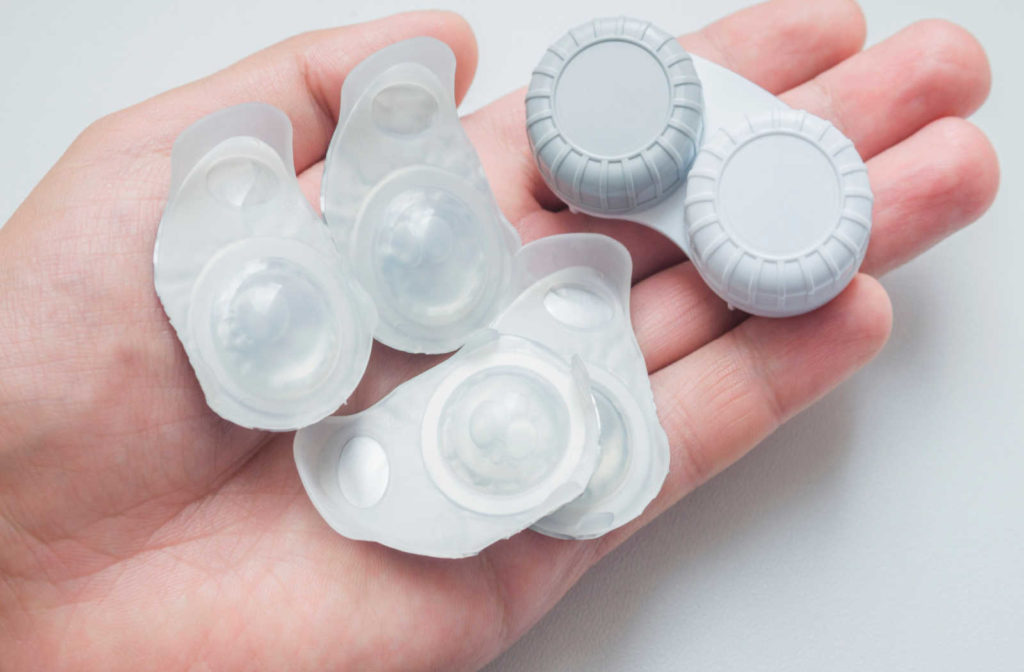Contact lenses have become a popular alternative to glasses, providing the freedom and convenience of not having to wear glasses all of the time.
With so many different types of contact lenses available, picking the right one can be difficult. Gas-permeable contact lenses, also known as GP lenses, are one option worth considering.
These lenses are made of a hard, permeable material that allows oxygen to reach the cornea, providing the wearer with clear vision and comfort.
How Do Gas Permeable Lenses Work?
Gas permeable contact lenses (GP lenses) are a type of rigid contact lens that’s made of a hard, permeable material that allows oxygen to pass through to the cornea.
These contact lenses are stiff and maintain their shape, as opposed to soft contact lenses, which are made of a flexible material that conforms to the shape of the eye.
The lens’s hard material alters how light enters the eye, effectively correcting vision problems such as:
- Astigmatism
- Nearsightedness
- Farsightedness
The material’s permeability allows oxygen to reach the cornea, promoting healthy eye function and lowering the risk of eye infections.
While they may take some getting used to, many people prefer the comfort and vision provided by GP lenses over other types of contact lenses once they’ve adjusted to them.

Who Can Wear Gas Permeable Contact Lenses?
Because gas-permeable contact lenses are appropriate for a wide range of visual problems, they are a viable option for many people who wear glasses or contacts. Here are some of the most common reasons why someone might require GP lenses:
- Astigmatism
- Nearsightedness or farsightedness
- Keratoconus
- Presbyopia
- Dry eye
Astigmatism
Astigmatism is a condition in which the cornea is irregularly shaped, allowing light to enter the eye at various angles and causing blurred vision. Astigmatism can be effectively corrected with GP lenses by reshaping the cornea and improving the way light enters the eye.
Nearsightedness or Farsightedness
Nearsightedness and farsightedness are common vision problems caused by an abnormally curved or flat cornea, causing light to focus in the wrong place in the eye. These conditions can be corrected with GP lenses by changing the way light enters the eye, resulting in clear vision.
Keratoconus
Keratoconus is a condition in which the cornea gradually thins and becomes more cone-shaped, resulting in distorted vision.
This can make it difficult for people with keratoconus to see clearly with glasses or soft contact lenses, as these lenses are not designed to correct the irregular shape of the cornea.
Gas permeable (GP) contact lenses, on the other hand, are made to fit the individual’s eye and can help correct vision in keratoconus patients by providing a new, clear surface for light to enter the eye.
Additionally, by providing a stable and consistent surface for the cornea and reducing the amount of stress on the eye, GP lenses can help slow the progression of keratoconus. This can help preserve the cornea’s health and prevent further vision loss.
Presbyopia
Presbyopia is a natural aging process that makes reading and close-up work difficult. Presbyopia can be corrected with GP lenses by changing the shape of the lens to help focus light on the retina.
Dry Eye
Gas-permeable contact lenses may be a good option for people with dry eyes because they allow oxygen to reach the cornea, promoting healthy eye function and lowering the risk of dry eye.
Some people, however, may still experience dry eye symptoms while wearing GP lenses, particularly if they have a more severe form of the condition. In these cases, your eye doctor may advise you to use artificial tear drops to help lubricate and moisturize your eyes.
How to Care for Your GP Lenses
Care for gas-permeable contact lenses is similar to care for other types of contact lenses. It’s important to follow your eye doctor’s instructions, but here are some general guidelines to keep in mind:
- Before inserting your contact lenses into your eyes, always clean them. Use a contact lens cleaner designed specifically for GP lenses and follow the directions on the bottle.
- Disinfect your contact lenses after cleaning them to kill any bacteria that may be present. Disinfecting GP lenses can be accomplished using a variety of methods, including solutions and disinfecting cases.
- When not in use, keep your contact lenses in a clean case. To prevent bacteria buildup, replace the case every 3 months.
- Follow your eye doctor’s recommended wear schedule. GP lenses should be replaced every 1—2 years, depending on your specific needs and the type of lens.
Ready for GP Lenses?
If you’re ready to try gas-permeable contact lenses, the first step is to schedule an appointment with Dr. Henslick Vision Center. Based on your individual vision needs and the overall health of your eyes, we can perform a comprehensive eye exam and determine if GP lenses are a good option for you.




